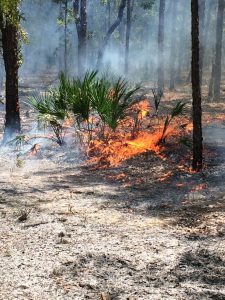Most plant and wildlife communities in Florida are adapted to periodic fires. For thousands of years, fires were ignited naturally, and frequently, by lightning. In fact, Florida has the greatest number of lightning strikes of any state in the country. About 1,000 lightning-set fires are documented in Florida each year.
Today, due to the many people living in Florida, the vast majority of fires naturally ignited by lightning are quickly suppressed by trained personnel. This is done to reduce the loss of human life and property. Although helpful to human safety in the short term, suppression of fire from natural areas for long periods of time can be problematic for all the native plant communities and wildlife that are adapted to periodic fire, and ultimately dangerous for humans as well. The longer our natural areas go unburned, the greater the accumulation of vegetative material that could serve as fuel for fire, and the greater the possibility of uncontrollable wildfires devastating natural areas, homes, and buildings when lightning strikes.
PRESCRIBED FIRES are an important tool: they are a safe alternative to wildfires. Prescribed fires are intentionally set under favorable weather conditions with the goal of stimulating the ecological benefits produced by natural wildfires. By selecting safe conditions for these burns and by preparing for them in advance by creating barriers to halt the spread of fire past desired borders, trained personnel have much more control over the results of these fires. The reason we often see and smell smoke in the spring is because this is the most popular time of year to use prescribed burning as a forest management tool.
Below are some of the benefits fire provides to the health of the many plants and wildlife that naturally occur in our state.
- Fire maintains required habitat conditions for many of Florida’s plant and wildlife species.
- Fire promotes fruit production of many woody plant species.
- Fire promotes flowering of herbaceous (non-woody) plant species.
- Fire promotes diverse herbaceous plants that serve as food for insects and wildlife.
- Fire scarifies seeds, breaking down their hard seed coats and promoting germination.
- Fire prepares sites for seeding or planting of species that require bare mineral soil.
- Fire creates growing conditions required by some cone-bearing trees. It reduces leaf litter on the soil surface, increases nutrient reserves, and canopy openings so that sunlight can reach the forest floor.
- Fire releases nutrients bound up in dead organic matter, ultimately increasing palatability, digestibility, and nutritional value of growing plants for wildlife.
- Fire can improve the quality of forage for grazing livestock.
- Fire changes the density of trees in the forest, creating space for some wildlife species.
- Fire removes hardwood thickets and vines in the understory of pine forests, making these areas more suitable for some wildlife species.
- Fire controls insect pests and diseases that afflict pine trees.
- Fire increases the rate of nutrient cycling of some elements and elevates soil pH.
- Fire creates a diverse habitat conditions when fires are patchy, leaving pockets of unburned areas.
- Fire reduces the risk of severe, high intensity wildfires that could cause harm to native plants and wildlife by preventing the accumulation of highly-flammable, dead vegetation.
The last week in January has been designated as Prescribed Fire Awareness Week in Florida. Early February has been designated as Prescribed Fire Awareness Week in Georgia. March is Prescribed Fire Awareness Month in South Carolina. Why are so many southern states making a big deal about prescribed fire? It is because we have recognized the importance of safe fires for both the health of our native plants and wildlife as well as the safety of our human residents and visitors. If you see or smell smoke in a nearby natural area, it might well be coming from a prescribed fire intended to benefit our natural plants and wildlife as well as our safety.
To learn more about prescribed burning in Florida, visit https://www.freshfromflorida.com/Divisions-Offices/Florida-Forest-Service/Wildland-Fire/Prescribed-Fire
- Bats: Friends of Farmers and Gardeners - October 10, 2019
- Why Do We Often See and Smell Smoke This Time of Year? - March 20, 2019
- It’s Bat Week! Did You Know Bats Eat Insect Pests? - November 9, 2018

